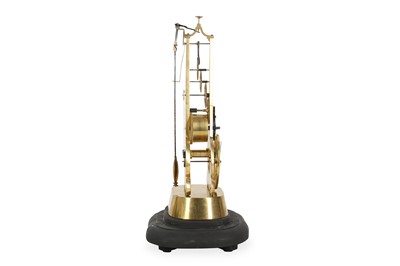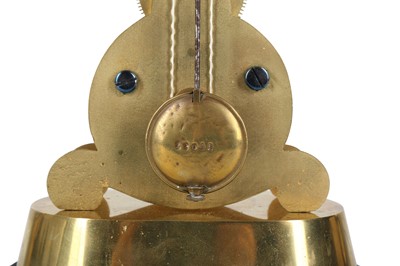27th Mar, 2019 10:00
Fine European Works of Art & Clocks
A RARE MID 19TH CENTURY ENGLISH BRASS SKELETON CLOCK WITH VERTICAL MOVEMENT AND OF TWO WEEK DURATION BY JOHN PACE, BURY ST EDMUNDS the frame with chamfered plates formed as a circle on a pair of scrolling supports beneath a vertical spire, raised on an oval base signed in Gothic style script 'John Pace Bury St Edmunds' over a stepped, ebonised plinth, the pierced, skeletonised dial with Arabic numerals with a dotted minute border, the movement with a going barrel of two week duration, high count pinions and very delicate wheels of five and six crossings mounted in a straight line through the central spire, with deadbeat escapement, the pendulum regulated by a knurled screw at the apex of the frame, mounted on the rear of the frame are two pulleys linked by a cord to drive the hands, with pendulum, under a glass dome, 38cm high excluding dome, 43cm high including glass dome The clock is running but not fully tested or guaranteed. COMPARATIVE LITERATURE: D. Roberts, 'British Skeleton Clocks', Woodbridge, 1987, pp. 89-95, plate 14 for an identical model. AUCTION COMPARABLE: Bonhams, London, 17 June 2008 lot 77 sold for £9000. A skeleton clock of one year duration was sold at Christie's, London, 17 March 2011, lot 129. John Pace was renowned for his clocks of long duration and specialised in skeleton clocks. He exhibited a similar clock to the present lot at the Great Exhibition of 1851 which was described as: "Pyramidal skeleton timepiece, which goes three months. The dial is placed at the bottom of the clock to show the motion of the wheels; Graham's dead beat escapement, and the hands moved by a simple mechanism." At the same exhibition he also displayed an exceptional three year duration skeleton clock.
Sold for £1,500
Includes Buyer's Premium
Do you have an item similar to the item above? If so please click the link below to submit a free online valuation request through our website.









